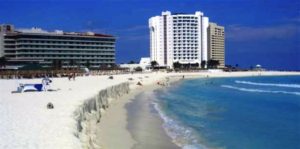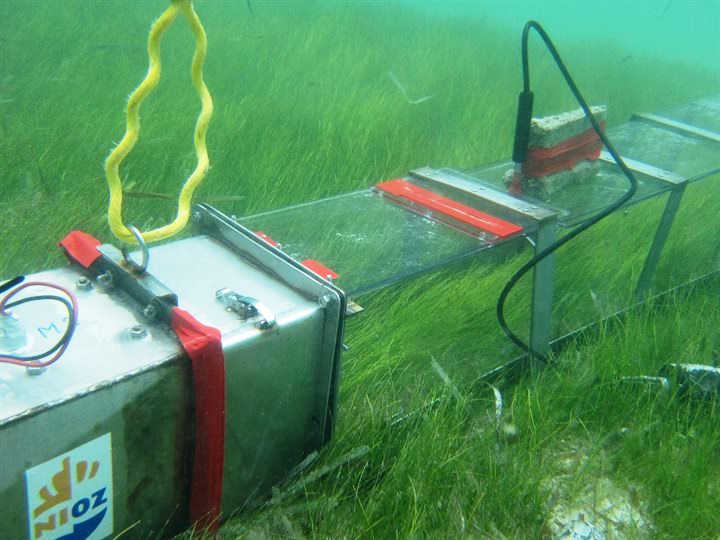Seagrass beds are so effective in protecting tropical beaches from erosion that they can reduce the need for regular, expensive beach nourishments that are presently used around the world. The multitude of creatures who eat sea grasses (such as sea turtles) and who live in it (such as seahorses) greatly benefit from this more-intelligent strategy as well.

Constant, expensive sand renourishment is required on Cancun’s beach, but it starts eroding immediately. Photo: Rodolfo Silva
“A foreshore with both healthy seagrass beds as well as calcifying algae, is a resilient and sustainable option in coastal defense.” said lead author Rebecca James, PhD-candidate at the Royal Dutch Institute for Sea Research (NIOZ), The Netherlands. “Because of erosion, the economic value of Caribbean beaches literally drains into the sea,” she added.
Increasing erosion with climate change:
The authors looked at beaches of the Caribbean Sea, where almost a quarter of the Gross Domestic Product is earned in tourism, mainly around the beaches. “With the increase of coastal development, the natural flow of water and sand is disrupted, natural ecosystems are damaged, and many tropical beaches have already disappeared into the sea”, co-author Rodolfo Silva, professor of Coastal Engineering at the Universidad Nacional Autónoma of Mexico says. “Until now, expensive coastal engineering efforts, such as repeated beach nourishments and concrete walls to protect the coast, have been made to combat erosion. Rising sea-level and increasing storms will only increase the loss of these important beaches.”
Experimental water flume:
To find out to what extent seagrass beds are able to hold sand and sediment on the beach foreshores, James and her promotor, professor Tjeerd Bouma (NIOZ), conducted a simple but telling experiment.
With a portable and adjustable field flume to regulate water motion in a Caribbean bay, they observed when particles on the sea bed started moving. “We showed that seagrass beds were extremely effective at holding sediment in place”, James says. “Especially in combination with calcifying algae that ‘create their own sand’, a foreshore with healthy seagrass appeared a sustainable way of combating erosion.”
The idea that seagrass has a positive effect on coastal protection and that this effect is reinforced by the presence of calcifying algae is in line with earlier research by Radboud University and NIOZ. “It’s nice to see our hypothesis confirmed by such an elegant experiment, in combination with long-term measurements in Mexico“, notes Radboud University’s Marieke van Katwijk, who is also James’ co-promoter.
More seagrass, less erosion:
Along the coastline of the Mexican peninsula of Yucatan, the team put their theory to the test. “By looking at beaches with and without protection of healthy seagrass beds, we showed that the amount of erosion was strongly linked to the amount of vegetation: more seagrass, meant less erosion.” co-author Dr. Brigitta van Tussenbroek of the Universidad Nacional Autónoma in Mexico (UNAM) says.
“At beaches where seagrass beds were destroyed, the researchers saw a sudden strong increase in erosion, resulting in an immediate need of expensive beach nourishments,” she explained.
Promising future prospects:
Both NGO’s and engineering industry welcome these novel insights. “To date, seagrass beds are too often regarded as a nuisance, rather than a valuable asset for preserving touristically valuable coastlines. This study could change this perspective completely”, Bas Roels of World Wildlife Fund Netherlands says. “The study opens opportunities for developing new tropical-beach protection schemes, in which ecology is integrated in engineering solutions”, adds Mark van Koningsveld from international marine contractor Van Oord.
According to co-author Johan Stapel of the Caribbean Netherlands Science Institute (CSNI) on St. Eustatius this will require a multilateral approach in conservation and restoration, as seagrass faces increasing pressure from various sources of pollution.and invasive species.
“Fortunately, NIOZ has a strong tradition in successfully restoring all kinds of coastal vegetation from seagrass to mangroves.” Bouma concludes.
The research was been carried out by marine scientists from the Netherlands (NIOZ, Utrecht University, Radboud University, Technical University Delft and Deltares) and Mexico (Universidad Nacional Autónoma de México) and St. Eustatius (Caribbean Netherlands Science Institute).
Featured image is a portable water flume designed at NIOZ that was used to measure the ability of seagrass to keep sand in place and prevent erosion. Photo credit: Rebecca James

